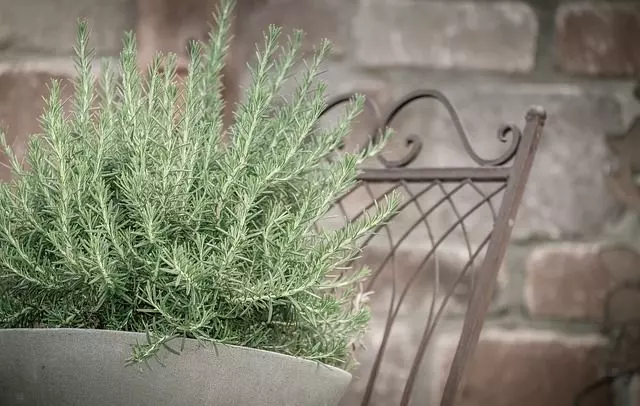Rosemary is an evergreen shrub with stunning blue flowers. It is a pungent and distinctive plant with a sweet, resinous flavor. It is ideal for a rock garden or at the top of the drywall. Read on and learn everything you need to know about How to Plant Rosemary.
This aromatic herb is indispensable for cooking, used as a decorative element in the garden, and aromatherapy. A member of the mint family, it grows as a perennial shrub in many climates and thrives easily in containers. There is no excuse not to grow some at home.
Regardless of the growing zone, Rosemary is a must for gardens. In warmer areas, this herb is the perfect candidate for container gardening, as long as it gets the light it needs and the soil is well-drained.
It is low maintenance, and in most cases is pest free. Its only concern might be powdery mildew, which can be avoided by not overwatering, providing adequate spacing, as well as good air circulation between its neighboring plants.
Although it can reach considerable size, it is slow-growing during its first year of establishment. It can grow between one and two meters in height, depending on where it is being planted.
As it mixes well with other herbs, use it lightly in food dishes with animal protein, soups, stews, and vegetables. It is no secret that rosemary’s flavor and aromatic qualities make it the perfect companion in sauces and baths to relax the body.
Table of Contents
How to Plant Rosemary
It is advisable to plant this perennial herb in warmer areas, within the landscape as a shrub, or where there are a variety of plants such as in a rock garden. If, on the other hand, you live in a colder area you can do the same in the garden, but when the cold winds arrive be prepared to bring it inside your home.
Growing Rosemary from seed generally produces low germination and excessive variation from its more common species. It is easy to propagate, even the roots develop best in a glass of water in a sunny window.
For sowing do it preferably in a container. Take the cuttings from a friend’s planting and do the process as follows:
Try to make a 2.7” (7 cm) cut from the tip of a stem.
Remove the leaves 0.8” (2 cm) from the base.
Apply a rooting hormone to the exposed part of the stem.
Get a pot or container with a good drainage system.
Use well-drained soil that is between pH 6 and 7.
Plant it in a rooting mix that includes moss.
Make sure its light needs are met.
This way, roots will begin to emerge within 3 to 4 weeks. To get a head start if you live in a warm area, plant the seeds or seedlings before the last cold spell in your location.

How to Care for a Rosemary Plant
Growing it indoors can sometimes be a difficult procedure. Many good gardeners have tried, and despite their best efforts, end up with a dry, brown, and dead Rosemary plant.
Therefore, to prevent this from happening to you try to take into account the general care we share with you below:
Keep a frequent eye on the soil of the plant that is not too dry or too wet to avoid root rot.
They should have 6 to 8 hours of strong and direct light. While 4 to 6 hours of weak or indirect light is also good for it.
Prune them regularly so that they do not die back too quickly.
Water them evenly throughout their growing season.
Be sure to divide it for next season.
Use time-release fertilizer at planting and reapply in the spring.

Pests Or Diseases
When established outdoors, insects are usually not a problem. However, indoors they are usually more likely to cause problems. Most of the time four factors kill Rosemary plants, these are:
Lack of sunlight: if it does not receive at least 6 to 8 hours of light per day, place a lamp with a fluorescent bulb as close as possible to supplement the sunlight.
Bad watering practices: one of the most common reasons for its death. Try to only water the soil when the top is completely dry to the touch.
Pests: whiteflies, spider mites, and mealybugs can frequently bother them. You can use neem oil, it is effective against pests, as well as harmless to humans and pets. You can also spray it with an insecticidal soap until it is healthy again.
Powdery mildew: to control this situation increase the air circulation around it. Place it in a more open place, you can also use a small fan for 3 or 4 hours a day.

Tips And Recommendations for Rosemary
If you know all the secrets for the proper care of this herb when growing indoors, you will be able to take advantage of it all year long. Whether you are an amateur gardener or an expert, take note of the best tips and general recommendations that we share with you below for optimal development.
The best way to grow Rosemary in a cooler area is to keep it in a mobile container. This way you will be able to enjoy this aromatic herb all year round.
Avoid buying the small shoots. Get a head start and pay for a larger sprout.
Make sure the drainage in the container is excellent.
Watering too much and too often will cause root rot.
Adding fertilizer to the soil during the spring will help its growth.
In the garden, plant near beans, cabbage, carrots, and sage.
Remember to leave at least three feet of space between each plant.
Learn more about How to Grow Herbs.
